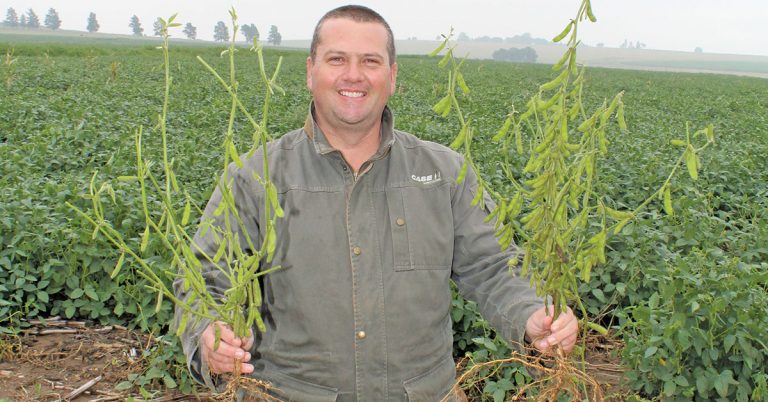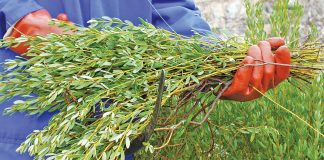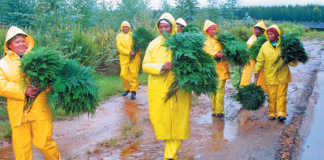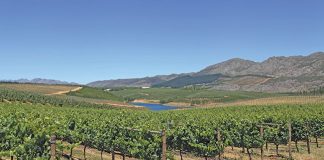
Photo: Lindi Botha
Growing up on the family grain and cattle farm in Balfour, Mpumalanga, Danie Bester developed an interest in computers alongside a love for farming.
This has benefitted him in an era of technology and precision farming, where GPS-linked systems and software programs have enabled him to optimise every square metre of his farm.
He also leans on a group of farmers in the US who share a common vision to obtain the maximum possible yield using the latest technology, their own research and shared learning.
“Being part of such a group has made a world of difference to the way I farm. I’m challenged to think differently about how we farm in South Africa, and question the norms,” says Bester.
New thinking
One of the shifts he has made is how he views potassium application in maize and soya bean.
“What I learnt studying agriculture, and from farmers in the US, is that our entire approach to fertilisation is wrong. I’ve seen first-hand that [South Africa is] light years behind. Our fertiliser programmes need a makeover because the levels of elements, especially potassium, aren’t where they need to be. We’ve advanced when it comes to the seed genetics we use, but somehow the prescribed fertiliser norms have stayed the same down the years.
“Our potassium levels are traditionally much lower than those of farmers in the US. We’ve focused all our attention on the genetics in the seed, but as they change, they have new requirements. Potassium is a big driver of yield and because the improved genetics have more potential, they need more nutrients to sustain that potential. Current norms, which were published in 1992 and minimally revised in 2003, are about 52% lower than the latest published norms in the US, which are also lower than those being used by high-yielding growers.”
Bester offers a word of caution, however: conduct tests yourself before applying any advice.
“And if you are going to seek advice, start with someone who is independent, not from a chemical or machinery company, and not driven by sales. Phone other farmers, as many as possible, and see which trends emerge. Learn to do things yourself; the sooner you do, the better off you’ll be.”
Improving the soil
Bester aims for a 50:50 ratio between maize and soya bean, and follows a no-till programme to optimise soil moisture retention, reduce compaction, and enhance the microbes in the soil.
He plants a mixture of radish and field peas as cover crops between the soya bean and maize rotations to ensure that the soil is not left bare to dry out. When ready to plant the next crop, he sprays herbicide to kill off the cover crop rather than harvesting it or ploughing it into the soil.
When switching from maize to soya bean, he plants winter wheat as a cover crop between rotations. This, he explains, has had a major effect on soil health.
“No-till in particular has had a big impact on the soya bean, as the crop is sensitive to changes in moisture and temperature. Because the soil is cooler and retains moisture, the plants are far less stressed and produce more flowers, and consequently more seed pods.
“Root development is also far better and the rhizobium concentration in the soil is increasing.”
Part of Bester’s plan to improve the soil involves correcting the pH level by adding lime and other elements as indicated by a soil analysis. Each year, he measures the yield to ascertain the effects of these adjustments.
“Results have shown that in certain lands we can obtain an increase in yield only when we add exactly the right amount of lime,” he explains.
“Soil samples are crucial to understanding where I am and where I need to be, and to monitor the impact of my actions. I apply inputs at variable rates, according to a soil analysis conducted on every half-hectare. I then compare soil samples six months and then a year down the line, so that I can see what the uptake and effect is. We do this every season to monitor the improvements over the years. It costs money, but it’s necessary.”
Tech is fundamental
At the heart of Bester’s farming operation is the technology obtained from Ag Leader. Through this software, he can calculate the cost of the applications for each input, compare them with yield and prices, and obtain an exact economic threshold of when applications no longer warrant the output.
“You can buy yourself a harvest by applying as much fertiliser and other inputs as possible, but it doesn’t help if you’re spending more money than you’re making,” he says.
Through the Ag Leader program, Bester has built up a mass of data to guide his decision-making.
“I use many years’ data to get exact measurements of what’s needed for a certain yield in certain soil types. I can see, for example, how the speed of planting influenced my yield. There’s so much information you can layer that hardly a day goes by when I don’t learn something new and gain a new understanding of how to do things better. As a result, profitability has improved because I have so much more insight into how to produce a great crop without wasting inputs.”
Precise applications
Bester bases his decisions on which seed variety to plant on the yields obtained from trials conducted on his farm. He aims to run these trials on every farm he owns or rents, all of which are scattered around the district and therefore have different soil types and climates.
He currently has 22 varieties of soya bean, all glyphosate-tolerant, planted commercially on the farm.
Around August, before soya bean planting begins, granular fertiliser is applied to the soil at variable rates using Ag Leader’s fertiliser control program, DirectCommand. This is a custom mix averaging 7kg/ha of nitrogen, 28kg/ha of phosphates and 64kg/ha of potassium. Microelements are also included.
Bester applies herbicide and insecticide seven to 10 days before planting, as he has found that applying the former at planting suppresses soya bean growth. These chemicals remain active for at least a month, so they could, in fact, be applied even earlier.
“I ran trials and found the soya bean crops that didn’t receive any chemicals at planting showed far better growth.
“Applying a chemical results in a layer of contaminated soil. But if this is done before planting, the planter shifts this soil out of the way as it digs the furrow for the seed, so the seed doesn’t have to break through the chemical layer when emerging.”
When, why and how
Bester believes in planting soya bean sooner rather than later in the season, as is usual in South Africa.
“I learnt this from the US study group, and have seen first-hand on my farm that it’s the best approach. A land that we planted on 12 October has to date produced an average of 202 pods/ plant; while a land planted on 3 November has produced an average of 65 pods/ plant. Planting earlier ensures more sunlight, which gives more time for flowering and hence more pods.
“The earliest I plant is 5 October, but it’s normally between 20 and 25 October. I plant at an average density of 210 000 plants/ha, but this varies, as density is cultivar-specific and dependent on the potential of the soil.”
Bester uses a DBX planter with a precision planter V-set, with Ag Leader seed control to ensure the correct planting rate. Ag Leader screens are fitted on the planters, and transfer data to his computer in real time. Fertiliser is applied with the seed at variable rates. Bester says that if ever there was a silver bullet to fix soya bean problems, Stoller’s Bio-Forge would be it.
“It’s a biological product that helps seeds germinate into healthy plants, even if the temperature dips. It’s especially useful during earlier planting when the soil temperature is a bit lower. We also apply the fungicides Apron XL and Celest XL at planting, and I always add molybdenum at about 0,5ℓ/ ha because it helps strengthen the plants.”
All the crops are grown under dryland conditions, and the area receives about 750mm of rain annually.
Continuous care
In soya plants, most of the yield potential is determined when the plants are about 20cm high.
“Anything you can do to aid the plants at that stage needs to be taken into consideration,” says Bester. “When the plants get to the V2 growth stage, I pull out an entire plant and send it for soil and leaf analysis. I then compare the data with that of previous years so I can get a good idea of what yield to expect. If the analysis shows that my soil is low on any element, then I know what to add to my first foliar application.
“I then take another leaf sample a week before doing the foliar application in order to do the fine-tuning. Generally, by this time all the plants require boron, a bit more molybdenum, and potassium.”
At around the R1 growth stage, he applies glyphosate, manganese and insecticide. The manganese prevents yellow flash in the leaves, common after applying glyphosate.
“At R3, there’s another small window of opportunity to gain a yield advantage. The leaves must be healthy, so we apply a fungicide and a small amount of foliar feed, based on the results of the leaf analyses.
“Insecticide is also applied again to protect the flowers. This step is omitted by many farmers, but the gain you achieve on yield outweighs the cost of the insecticide. I’m in the field twice a day and if there are harmful insects, I spray. The return on investment is worth it.
The more potential you can maintain throughout the plant’s life, the better. For every step you skip, you can lose 0,5t/ha of yield.”
Reaping the rewards
Bester achieves an average yield of 3,1t/ha on dryland, while some of the fields he rents dip to 1,7t/ha. However, a small field where Bester applies highly intensive management reached 7,12t/ha of soya bean on one occasion.
He harvests at maximum moisture levels to retain all the pods.
“If your plants’ nutrition is at the correct levels, the pods should remain intact. Calcium
is especially important to help the beans maintain their moisture. The only way to do this is to ensure that your lime applications are done correctly at the start of the season and that the pH is correct. I’ve tried several calcium products, but there isn’t enough calcium uptake through the leaves. It needs to be done through the soil, and at the start.”
Harvesting is done with a Case IH Axial-Flow combine equipped with an Ag Leader InCommand display for yield mapping, using Real-Time Kinematic correction. Once harvesting begins, all the information is sent to Bester’s phone and computer.
“I start analysing the data to see where changes occurred and what had an influence on the yield. This information is correlated with the soil and leaf samples, what I ended up applying, what it cost me, and what worked. I speak to the US study group about emerging patterns or why something reacted in a certain way. Then I refine the next year’s fertiliser programme based on these results.”
Must-have equipment
Bester says that the harvest monitor is an essential piece of equipment for him.
“It’s the report card of the season. I can’t do anything next year if I don’t know what I did right or wrong this year.
“The best advice I can give to farmers is this: don’t do this year what you did last year and expect a better yield. If you get a hectare with a higher yield, take a soil and leaf sample and compare it with samples from the other lands. Ask questions and investigate. The best way to learn is to check things for yourself.”
Email Danie Bester at [email protected].













